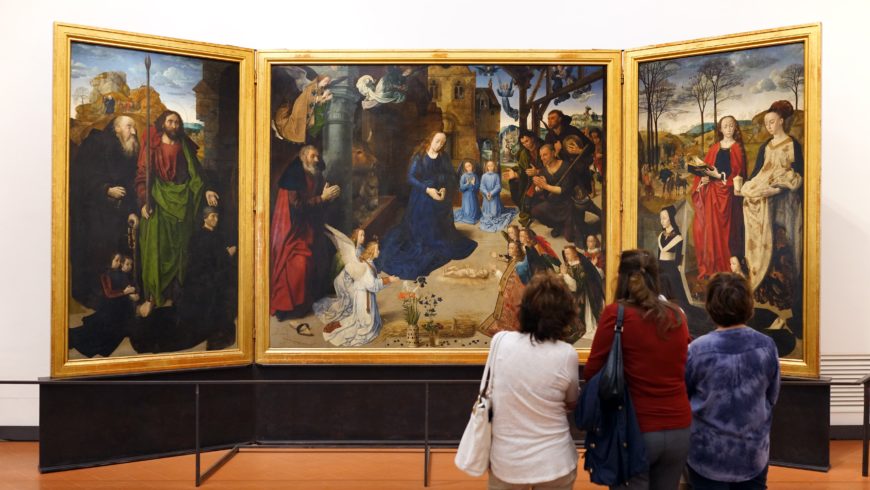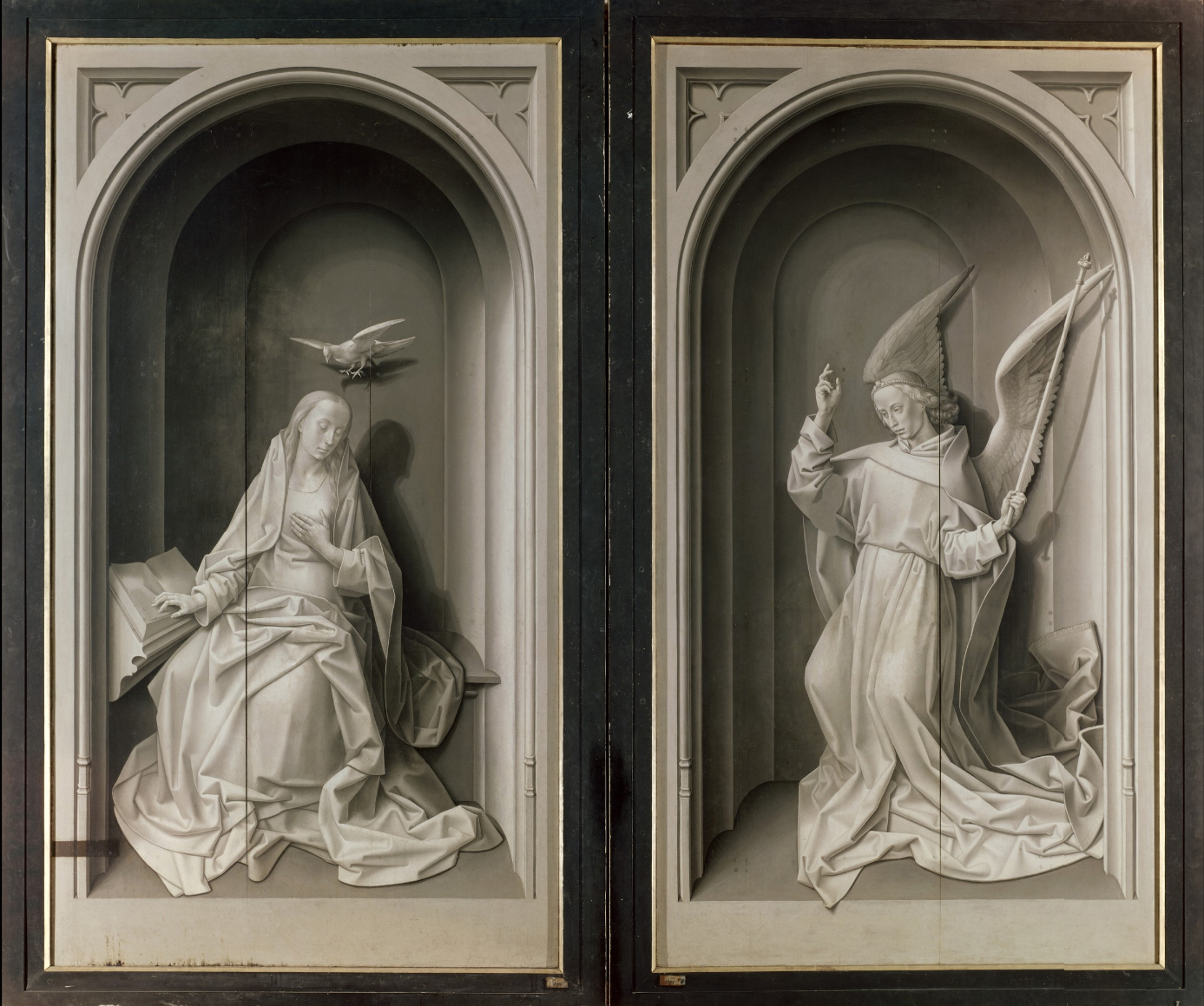Rennisance-Portinari Altarpiece


Background
This piece is a small portion of a larger work, called the Portinari Altarpiece, painted in 1476 by artist Hugo van der Goes. The full piece is a triptych, which is a large, three-panel piece of artwork that unfolds to reveal the painting within. The work was commissioned by Tommaso Portinari, a wealthy Italian banker who worked within the Medici network.
The altarpiece resided within the Sant'Egido church in Florence, acting as the main altarpiece. It was only opened for holidays and feasts, the outer doors of the piece bearing the painted statues of two angels for decoration. (Howard) I will be focusing on the redheaded girl found at the very top of my post, but have included the interior and exterior of the triptych for your reference and enjoyment.
Connections To The Medici Dynasty
The Medici dynasty was one of the most powerful dynasties during this time. They were well-known patrons of the arts, and had close connections with the Catholic church, collecting funds and serving the pope himself. They had a complex system of banking franchises, where independent business owners would run a branch of the bank and reap the wealth it generated. (Medici: Godfathers of the Renaissance)
Without this banking system, Portinari may never have had the money needed to commission such a daunting piece of art. This franchise centered system meant the dynasty's wealth and influence was not limited only to their family members, but also included the beneficiaries of their franchise. (History.com)
Their system of banking, in my opinion, made wealth more accessible to the common man, by giving them an opportunity to run a successful business. Patronage of the arts was very common among the wealthy, so it is safe to say that without the Medici's influence and wealth generated by the individual banks, much of the artwork we treasure today may have never existed. Most people simply could not afford to commission painters without the opportunity lent by the Medici banks.
An interesting note about this piece in particular is that it included the members of the Portinari family. By commissioning themselves to be painted within the work, they believed that any prayers that took place in the church would benefit them. (Howard) This decision was likely influenced by the churches stance on banking, and the associated loopholes.
Banking itself was especially linked to the arts, as a donation of religious pieces was seen as a penance for moneylending, a sin within the church. By donating these pieces, bankers thought that they would be forgiven by God, because they used their wealth to glorify God and religion. (National Gallery of Art) As the largest banking dynasty in Italy at this time, it is undeniable that the Medici's played a major part, both indirectly and directly, in the rich artistic history of the Renaissance.
My Opinion
I absolutely love this piece of art. It represents the complex beauty of the Northern Renaissance, with lifelike precision held in every brushstroke, and vibrant colors packed into every inch of the piece.
In my opinion, the greatest contributing factor to this pieces beauty is the artist's use of color. Red and green oppose each other on the color wheel, lending the piece a strong sense of contrast. This really makes the girl stand out, independent of her background. Using such harsh color differences was a very ambitious choice that was perfectly executed here. The background harshness versus the girls' more muted appearance easily draws the reader's eye to the centerpiece. Although some of this detail is lost when viewing the whole work, it is a lovely standalone piece.
Additionally, the way that van der Goes composed this piece is extremely clever. The girl is placed perfectly, to avoid her orange hair clashing with the red in front of her. The black headpiece splits the painting in half, allowing the intricacy and vibrancy of her hair to stand out independently from the rest of the painting.
Finally, the tone in this piece is very striking. Especially on the girls' face, varied shades of brown are used to suggest dimension, and darkened greens lend the dress an almost wrinkled appearance. By manipulating tone, the artist is able to perfectly represent reality, which doesn't usually include harsh lines and blackened shadows. By mastering the tone of the piece, the painting comes alive on the canvas.
I would personally opt to not own this full work, due to its daunting size. However, I would love to own a smaller print of the girl, because she particularly caught my eye when I was viewing this piece. It would be a far more manageable way to appreciate the work without consuming so much space.
I can't say I relate to the backstory of this piece. I am not religious, and don't fully understand the appeal of commissioning work specifically for a church. However, this does not detract from my appreciation for the stunning work that van der Goes completed.
Sources
History.com Editors. “The Medici Family.” History.com, A&E Television Networks, 9 Nov. 2009, www.history.com/topics/renaissance/medici-family.
Howard, Dr. Rebecca, and Dr. Rebecca Howard. “Hugo Van Der Goes, Portinari Altarpiece.” Smarthistory, smarthistory.org/van-der-goes-portinari/.
“Medici: Godfathers of the Renaissance . Medici . God's Bankers.” PBS, Public Broadcasting Service, www.pbs.org/empires/medici/medici/bankers.html.
“National Gallery of Art.” Patrons and Artists in Late 15th-Century Florence, www.nga.gov/features/slideshows/patrons-and-artists-in-late-15th-century-florence.html.

Love your analysis of this work! There is something I find special about triptychs. They tell a story, almost like the renaissance version of a comic book. This is quite the beautiful painting and given that the little girl is only a small part of the overall piece, I love the detail put into her. The girl's hair I find the most striking with the individual strands being painted, which I'm sure was not easy.
ReplyDeleteYou have unique way of describing Portinari's Triptych paintings, and this history that surrounds these individuals; living underneath the Medici Family. These paintings are spectacular and have a way to describe itself through its size, colors and for the fact that these were created to represent actual people themselves during the Renaissance, rather than a painting from the Bible. The size of the triptych's are enormous and yet very well preserved. The shadowing and tinting with bright colors create an image that can bring your mind to this Era in history, explaining the occurrence's these people lived through; plagues, wars, rise of banking systems, and slowly moving into Humanism from religion. Great choice, they caught my attention and I learnt of a new painter I have not specifically studied.
ReplyDeleteGreat post! Thanks for sharing more background about the time period-- especially about how the bankers would try to earn forgiveness.
ReplyDeleteI have never seen this painting before but it really stands out-especially the portrait you chose. I was also struck by the detail, specifically in her expressive eyes. It looks like there are also some patterns with geometric shapes, especially on her dress. The triptych was popular as part of the Northern Renaissance but, considering the size, I can't blame you for not wanting your own copy!